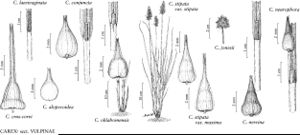Carex alopecoidea
Enum. Meth. Caric., 18. 1843.
Plants with basal sheaths of previous year persistent as linear fibers. Culms to 80 cm × 4 mm, scabrous. Leaves: sheaths all with blades, fronts smooth, red spotted, indistinctly linearly veined, apex hyaline, colorless, fragile, convex, entire; ligules rounded, 5 mm, free limb to 0.5 mm; blades dark green, not epistomic, to 60 cm × 7 mm. Inflorescences densely spicate, elongated, cylindric, with 8–12 branches, 2–4 × 1.5 cm; proximal internode to 0.5 mm; proximal bracts setaceous, apparent. Scales coppery with hyaline margins. Perigynia pale-brown, coppery distally, faintly 3–5-veined or veinless abaxially, veinless adaxially, to 4 × 1.7 mm, base not distended proximally, rounded; stipe to 0.2 mm; beak to 2 mm, serrulate. Achenes circular, 1.5 × 1.3 mm; stalk to 0.15 mm; persistent style base cylindric. 2n = 68.
Phenology: Fruiting Jul.
Habitat: Seasonally saturated soils in wet meadows, openings in alluvial woods, stream banks, particularly on calcareous substrates
Elevation: 0–1500 m
Distribution

Man., N.S., Ont., Que., Sask., Conn., Del., D.C., Ill., Ind., Iowa, Ky., Maine, Md., Mass., Mich., Minn., N.J., N.Y., N.Dak., Ohio, Pa., Vt., Wis.
Discussion
Morphologically Carex alopecoidea is most similar to C. conjuncta; it differs in the smooth sheath fronts and the abaxial veins faint or absent.
Selected References
None.
Lower Taxa
"shortened" is not a number."elongated" is not a number.
